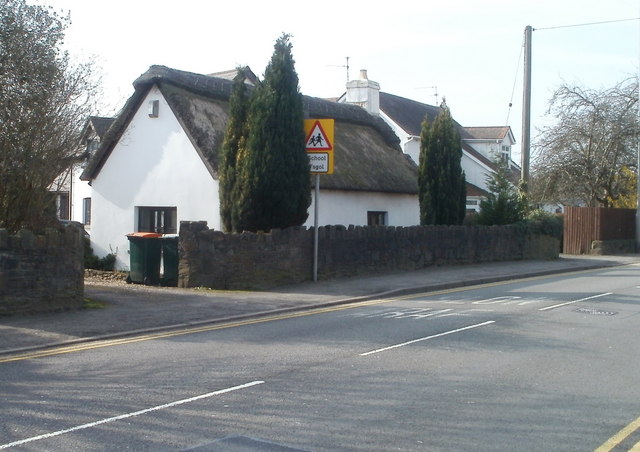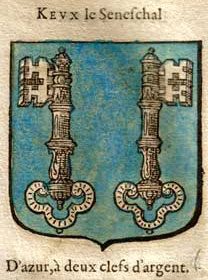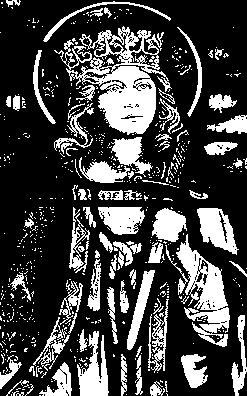|
Gwladys
Saint Gwladys ferch Brychan () or St Gladys ( la, Gladusa), daughter of King Brychan of Brycheiniog, was the queen of the saint-king Gwynllyw Milwr and the mother of Cadoc "the Wise", whose ''Vita'' may be the earliest saint's life to mention Arthur. Gwladys's other children were Cynidr, Bugi, Cyfyw, Maches, Glywys II and Egwine. Today her main church and associated school is in Bargoed. Traditional history The medieval lives of Cadoc (by Lifris c. 1086) and of Gwynllyw (c. 1120) preserve different legendary details of Gwladys. Among the best attested of all of Brychan's half-Irish saintly children, she is also mentioned in Welsh king-lists. Both saint's lives agree that Gwladys, daughter of Brychan married Gwynllyw and gave birth to Cadoc. In the ''Life of Saint Gwynllyw'', the king is just and fair and the marriage is accomplished peacefully, while the tale of Glwadys' marriage in Lifris' work seems similar to abduction stories in other saints' lives as well as in other A ... [...More Info...] [...Related Items...] OR: [Wikipedia] [Google] [Baidu] |
Bassaleg
Bassaleg ( cy, Basaleg) is a suburb on the west side of Newport, Wales. It is in the Graig electoral ward and community.Bassaleg is located two miles northwest of Newport city centre. Bassaleg is bounded by the A467 road (A4072) to the east, the railway spur to Lower Machen (the former Brecon and Merthyr Railway) to the north, the St Mellons Road (B4288) to the south and Rhiwderin to the east. The Ebbw River runs through the area. The A468 road passes through towards Caerphilly and junction 28 of the M4 motorway is less than a mile to the south. St Basil's Church The parish church of St. Basil's is a Grade II* listed building. It has been suggested that site of the church was originally dedicated to Saint Gwladys. Historians have suggested that Bassaleg is the only British place whose name derives from the word ''basilica'', a term used in early Christianity for a church containing the body of a saint. Until the mid-19th century, a grave chapel for St. Gwladys survived clos ... [...More Info...] [...Related Items...] OR: [Wikipedia] [Google] [Baidu] |
Brychan
Brychan Brycheiniog was a legendary 5th-century king of Brycheiniog (Brecknockshire, alternatively Breconshire) in Mid Wales. Life According to Celtic hagiography Brychan was born in Ireland, the son of a Prince Anlach, son of Coronac, and his wife, Marchel, heiress of the Welsh kingdom of Garthmadrun (Brycheiniog), which the couple later inherited. Upon his father's death, he returned to Garthmadrun and changed its name to Brycheiniog. Brychan's name may be a Welsh version of the Irish name Broccán and that of his grandfather Coronac may represent Cormac. Brychan's education was entrusted to one Drichan. The ''Life of St. Cadoc'' by Lifris (''c''. 1100) portrays Brychan fighting Arthur, Cai and Bedivere because of King Gwynllyw of Gwynllwg's abduction of his daughter St. Gwladys from his court in Talgarth. Portraiture and veneration He is occasionally described as an undocumented saint but the traditional literature does not call him a saint, referring to him as a patria ... [...More Info...] [...Related Items...] OR: [Wikipedia] [Google] [Baidu] |
Gwynllyw
Gwynllyw Filwr or Gwynllyw Farfog (), known in English in a corrupted form as Woolos the Warrior or Woolos the Bearded ( la, Gundleus, Gundleius or Gwenleue; 450 – 500 AD) was a Welsh king and religious figure. He was King of Gwynllwg in South Wales and is the legendary founder and patron saint of the City of Newport living around the 5th century. According to medieval tradition he was a feared warlord and raider who knew King Arthur, but later found religion and became a hermit founding St Woolos Cathedral in Newport. He was the father of one of the most revered Welsh saints, Saint Cadoc the Wise. Traditional history The medieval lives of Saint Cadoc (c. 1100) by Lifris and of Saint Gwynllyw (c. 1120)'Vita sancti Gundleii', Vitae sanctorum Britanniae et genealogiae, ed. A. W. Wade-Evans (1944), 172–93 preserve legendary details of Gwynllyw, though details frequently differ. He is also noted in Welsh king lists. The saint's lives note that his deeds were celebrated by Wel ... [...More Info...] [...Related Items...] OR: [Wikipedia] [Google] [Baidu] |
Cadoc
Saint Cadoc or Cadog ( lat-med, Cadocus; also Modern Welsh: Cattwg; born or before) was a 5th–6th-century Abbot of Llancarfan, near Cowbridge in Glamorgan, Wales, a monastery famous from the era of the British church as a centre of learning, where Illtud spent the first period of his religious life under Cadoc's tutelage. Cadoc is credited with the establishment of many churches in Cornwall, Brittany,''Martyrologium Romanum'', 2004, Vatican Press (Typis Vaticanis), page 529. Dyfed and Scotland. He is known as ''Cattwg Ddoeth'', "the Wise", and a large collection of his maxims and moral sayings were included in Volume III of the Myvyrian Archaiology. He is listed in the 2004 edition of the Roman Martyrology under 21 September. His Norman-era "Life" is a hagiography of importance to the case for the historicity of Arthur as one of seven saints' lives that mention Arthur independently of Geoffrey of Monmouth's ''Historia Regum Britanniae''. Biography Cadoc's story appears ... [...More Info...] [...Related Items...] OR: [Wikipedia] [Google] [Baidu] |
Egwine
Egwine was a 6th-century Celtic princess and saint, who is a patron saint of the village of Llanigon, east of Hay-on-Wye, in the Wye Valley of Wales. Very little is known of her life. She was the sister of saints Cadoc, Maches and Cyndr, who all built churches in the same area. She was also the daughter of Gwladys,Lifris, 'Vita sancti Cadoci', Vitae sanctorum Britanniae et genealogiae, ed. and trans. A. M. Wade-Evans (1944), 24–141 and granddaughter of king Brychan of Brycheiniog Brycheiniog was an independent kingdom in South Wales in the Early Middle Ages. It often acted as a buffer state between England to the east and the south Welsh kingdom of Deheubarth to the west. It was conquered and pacified by the Norman .... References {{authority control Southwestern Brythonic saints English Roman Catholic saints 6th-century Christian saints 6th-century Christians Year of birth unknown ... [...More Info...] [...Related Items...] OR: [Wikipedia] [Google] [Baidu] |
Bargoed
Bargoed ( cy, Bargod) is a town and community in the Rhymney Valley, Wales, one of the South Wales Valleys. It lies on the Rhymney River in the county borough of Caerphilly. It straddles the ancient boundary of Glamorgan and Monmouthshire, with Bargoed lying in Glamorgan and Aberbargoed in Monmouthshire. 'Greater Bargoed', as defined by the local authority Caerphilly County Borough Council, consists of the towns of Bargoed and Aberbargoed and the village of Gilfach. The combined population of these settlements is about 13,000. The town's rugby club Bargoed RFC holds the world record for the most consecutive league wins in a row and was ''World Rugby'' magazine's team of the year in 2005. The town’s football team AFC Bargoed who also hold a rich history are currently rebuilding and have a good young squad, finishing 2nd in the TERV Premier League 2022 Toponymy The name of the town is derived from that of the River Bargoed, which itself is based on the Welsh word "border, bound ... [...More Info...] [...Related Items...] OR: [Wikipedia] [Google] [Baidu] |
St Gwladys Bargoed School
Bargoed ( cy, Bargod) is a town and community in the Rhymney Valley, Wales, one of the South Wales Valleys. It lies on the Rhymney River in the county borough of Caerphilly. It straddles the ancient boundary of Glamorgan and Monmouthshire, with Bargoed lying in Glamorgan and Aberbargoed in Monmouthshire. 'Greater Bargoed', as defined by the local authority Caerphilly County Borough Council, consists of the towns of Bargoed and Aberbargoed and the village of Gilfach. The combined population of these settlements is about 13,000. The town's rugby club Bargoed RFC holds the world record for the most consecutive league wins in a row and was ''World Rugby'' magazine's team of the year in 2005. The town’s football team AFC Bargoed who also hold a rich history are currently rebuilding and have a good young squad, finishing 2nd in the TERV Premier League 2022 Toponymy The name of the town is derived from that of the River Bargoed, which itself is based on the Welsh word "border, bound ... [...More Info...] [...Related Items...] OR: [Wikipedia] [Google] [Baidu] |
Cyfyw
Cyfyw was a 6th-century princess and pre-congregational Saint of Cornwall and Wales. She was the sister of St. CadocBrian Daniel Starr, The Life of Saint Brychan: King of Brycheiniog and Family (Brian Daniel Starr, 2008)p38. Cynidr and Maches. Cyfyw was born to Saint Gwynllyw and his wife Gwladys. She was commemorated with a shrine A shrine ( la, scrinium "case or chest for books or papers"; Old French: ''escrin'' "box or case") is a sacred or holy space dedicated to a specific deity, ancestor, hero, martyr, saint, daemon, or similar figure of respect, wherein they ... at St David's Church, Llangeview. References {{authority control Southwestern Brythonic saints English Roman Catholic saints 6th-century Christian saints Year of birth unknown Year of death unknown ... [...More Info...] [...Related Items...] OR: [Wikipedia] [Google] [Baidu] |
Bedivere
Bedivere ( or ; cy, Bedwyr; la, Beduerus; french: link=no, Bédoier, also Bedevere and other spellings) is one of the earliest characters to be featured in the legend of King Arthur, originally described in several Welsh texts as the one-handed great warrior named Bedwyr Bedrydant. Arthurian chivalric romances, inspired by his portrayal in the chronicle ''Historia Regum Britanniae'', portray Bedivere as a Knight of the Round Table of King Arthur who serves as Arthur's marshal and is frequently associated with his brother Lucan and his cousin Griflet as well as with Kay. In the English versions, Bedivere notably assumes Griflet's hitherto traditional role from French romances as the one who eventually returns Excalibur to the Lady of the Lake after Arthur's last battle. Bedwyr In early Welsh sources, Bedwyr Bedrydant ("Bedwyr of the Perfect Sinew") is a handsome, one-handed warrior under Arthur's command. His father is given as Pedrawd or Bedrawd, and his children as Am ... [...More Info...] [...Related Items...] OR: [Wikipedia] [Google] [Baidu] |
Sir Kay
In Arthurian legend, Sir Kay ( cy, Cai, Middle Welsh ''Kei'' or ''Cei''; la, Caius; French: ''Keu''; Old French: ''Kès'' or ''Kex'') is King Arthur's foster brother and later seneschal, as well as one of the first Knights of the Round Table. In later literature he is known for his acid tongue and bullying, boorish behaviour, but in earlier accounts he was one of Arthur's premier warriors. Along with Bedivere, with whom he is frequently associated, Kay is one of the earliest characters associated with Arthur. Kay's father is called Ector in later literature, but the Welsh accounts name him as Cynyr Ceinfarfog. Cai in Welsh tradition Cai or Cei is one of the earliest characters to be associated with the Arthurian mythology, appearing in a number of early Welsh texts, including ''Culhwch ac Olwen'', '' Geraint fab Erbin'', '' Iarlles y Ffynnon'', ''Peredur fab Efrawg'', ''Breuddwyd Rhonabwy'', ''Pa Gur'', and the Welsh Triads. His father is given as Cynyr Ceinfarfog (Fork-Beard ... [...More Info...] [...Related Items...] OR: [Wikipedia] [Google] [Baidu] |
Maches
St. Maches was a 6th-century princess and Pre-congregational saint of Cornwall and Devon. Maches was the sister of St. Cadog. Born a daughter of Saint Gwynllyw and his wife Gwladys, Maches lived as a hermit, and was murdered by thieves, at Merthyr Maches ( Llanfaches in the Kingdom of Gwent). She was buried in the monastery at Caerwent, now the parish church of St. Stephen at Caerwent, by Saint Tathan
Saint Tathan (also known as Tatheus) is claimed to be a fifth or sixth century Celtic saint, who travelled fr ...
[...More Info...] [...Related Items...] OR: [Wikipedia] [Google] [Baidu] |
Coedkernew
Coedkernew ( cy, Coedcernyw) is a community in the south west of the city of Newport, South Wales, in the Marshfield ward. The parish is bounded by Percoed reen to the south, Nant-y-Selsig to the southwest, and Pound Hill to the west. The northern boundary is formed from Gwern-y-cleppa to junction 28 of the M4, then the A48 Cardiff Road. The eastern boundary is formed from the Ebbw River Bridge roundabout to the west of the International Rectifier plant, Duffryn Drive, along the southern edge of Tredegar House country park, Pencarn Lane and Percoed Lane. Despite being a mostly rural parish to the south and west, the north and east is a continuation of the Duffryn built-up area, and has seen large increases in population in recent years due to the continued suburbanisation of Newport; it grew from 574 in 2001 to 2,183 in 2011. This built-up area of Coedkernew forms a crescent around Duffryn and as such, much newly built housing in the Duffryn area actually falls within Coedker ... [...More Info...] [...Related Items...] OR: [Wikipedia] [Google] [Baidu] |

_Eglwys_Aberhonddu_(Brecon%2C_Wales)_02.jpg)

%2C_Pengam%2C_Bargoed_(19363299009).jpg)



